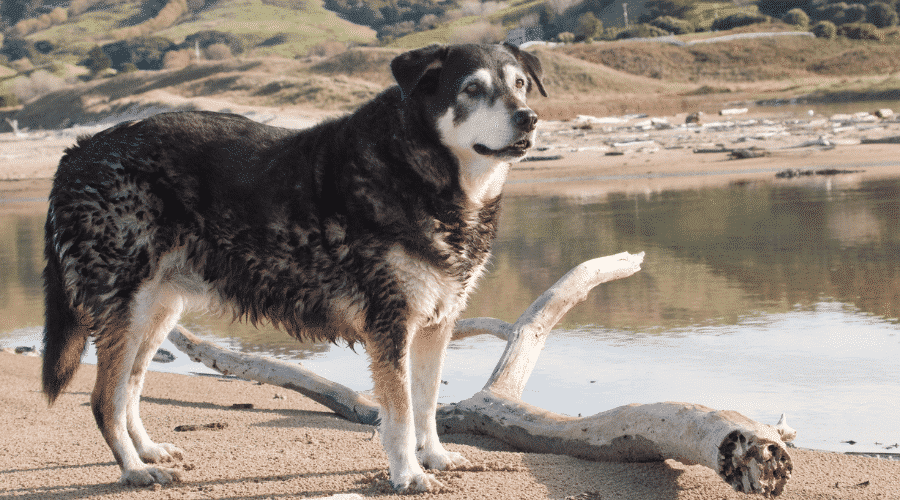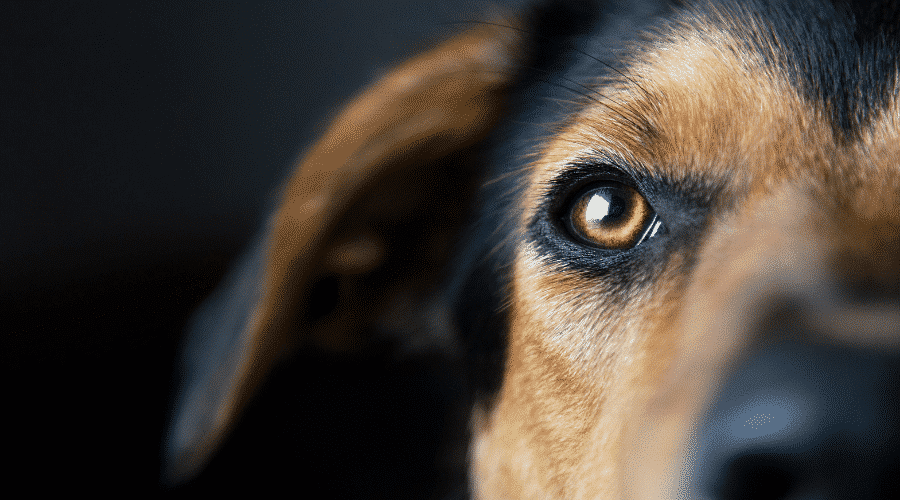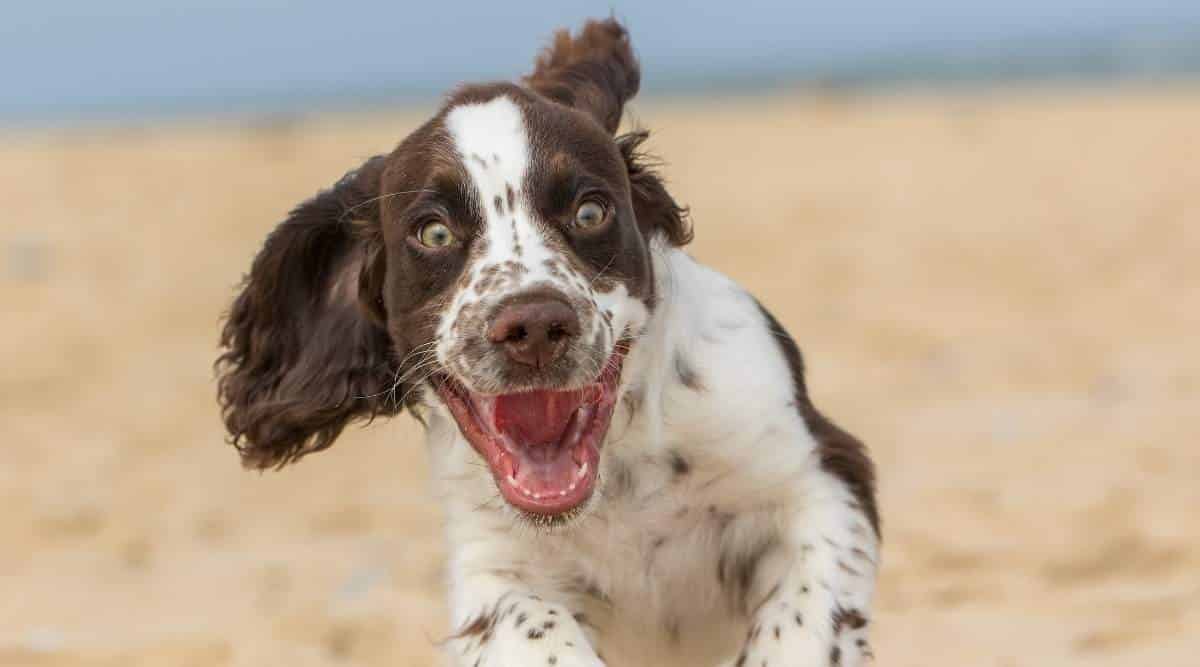Huntaway Information: Breed Facts, Traits, And More
When you purchase through links on our site, we may earn a commission. Here’s how it works.
The Huntaway dog have had one of the greatest increases in U.S. web searches in the past two years. This is a strong indicator that Americans are becoming more and more enamored with this dog. Based on his name alone, the Huntaway is an adventure waiting to happen.
Table of Contents
The trainability and ruggedness of this breed make the Huntaway an excellent fit for the right family. Still, these working dogs retain those original herding traits and best suit a family that can embrace their unique character.
Does the name Huntaway intrigue you? Does the idea of a handsome black and tan, rough and ready companion sound perfect? Let’s explore this exciting breed from New Zealand to see if this is the dog for you. Get to know the traits and history of this energetic and friendly breed to see if he is the right fit for your lifestyle.
Breed History

The New Zealand’s National Kennel Club recognizes the Huntaway as the country’s only indigenous dog breed. The breed’s earliest known mention in print was a farmer’s advertisement in an 1884 edition of the Otago Daily Times for a sheepdog “broken on rough country.” New Zealand’s challenging terrain demanded a dog who could push livestock (generally sheep) towards the stockman’s destination over many miles and hundreds of acres.
Like most dog breeds, the Huntaway was bred to fill a human need. Sheep farming was the most important farming industry in New Zealand from 1856 to 1987. The steep, hilly terrain required a herding dog with specific differences from the early herding dogs that became the well-known Border Collie breed, still the most popular herding dog on sheep farms in the United Kingdom. New Zealand farmers needed a dog with superior strength as well as speed and trainability. Using his strong bark, the new breed would “push” livestock across the vast countryside.
To create a breed with the strength and stamina to cover this rough country, farmers crossed the typical herding dog, the Border Collie type, with larger breeds, including the Foxhound and the Doberman. This cross added strength and size and gave the dogs the aggressive voice necessary to push their stock.
Huntaways are now becoming known as top herding dogs around the world. While still rare in the US and not yet recognized by the American Kennel Club, we can expect to see more of this outdoorsy breed in the not-so-distant future.
Temperament

Huntaways were specifically bred to herd stock by barking behind the flock and pushing them in a specific direction. The same traits for which they have been selected determine how they interact within their human and pet family. Huntaways are notably loyal to the family member they consider their master, but they are affectionate and congenial with all members of the family and are gentle with children. The farmers who created the Huntaway breed needed dogs that could do their job independently and far away from the herdsman, so “they have to be totally trustworthy,” explains Mr. Brian Davies, a breeder of Huntaway dogs in Mid-Wales.
Because Huntaways are working dogs, they require adequate exercise to stay healthy. A Huntaway can run over ten miles per day, and the breed was developed for large farms with hundreds if not thousands of acres. Such a dog needs a large fenced yard and daily social interaction with his family to remain fit in body and mind.
Anyone who plans to have a Huntaway as a companion must remember that the breed’s original designers required a dog with a loud and frequent bark. Huntaways perform their job by following their sheep and barking loudly to push them forward. Although working Huntaways are trained to “speak up” and “quiet” by their herdsman who uses their bark upon command, a trait so deeply embedded in a dog’s DNA will be difficult to control completely in a companion animal. Consider the generous voice your Huntaway will cheerfully offer before adding one to your family. If your situation requires a silent companion, the vociferous Huntaway may not be for you.
Size And Appearance

Huntaways are large dogs, but they can vary in appearance but have common traits because of their breeds of origin. They have a strong build and generally have distinctive black and tan markings that reflect the Doberman influence, but there is diversity within the breed, even down to their color.
Coat And Color

While most Huntaways are black and tan, breed standard allows for brindle, black, or white and a combination thereof. Huntaways may have either rough or Border Collie style coats and some even resemble black Labrador Retrievers. As a breed created by crossing dogs with such different coat types (the smooth short hair of the Foxhound and Doberman and the longer, feathery coat of the Border Collie), there is variability in coat type from individual to individual. The Huntaway may have either a smooth or broken coat.
Exercise Requirements

Huntaways run miles per day to herd their flocks. They have a natural need for lengthy periods of exercise. If his owner denies a high-energy dog an appropriate outlet for his energy, it may manifest in undesirable ways. This is especially true before he is fully mature at eighteen months to two years of age.
These dogs cover a lot of ground, and they naturally herd other animals. Be sure this instinct doesn’t make them the neighborhood pariah. They do not have a high prey drive nor a strong instinct to guard, so they generally welcome new humans. If most of your Huntaway’s exercise will take place in a public space such as a dog park, recognize that his bark may make some of your fellow dog owners uncomfortable.
Huntaways bond strongly with one person but still enjoy the company of the whole family. These high-energy dogs will relish a leashed jog with their favorite human companions. Be sure to train your dog to bark on command and stop as reliably to be an excellent canine citizen in a park or neighborhood.
Living Conditions

Remember your pet’s unique background when you decide to bring a Huntaway into your family. Your companion will need access to a large fenced yard. Because he can cover more ground than many dogs his size, you must fence securely to keep your Huntaway safely at home.
Huntaways bond strongly with their masters and will look to you and your family’s attention and interaction. Spend time daily with your companion and give him the sense of purpose a working dog craves. Work daily with your dog to train him how to use his bark. Direct his actions in the field to strengthen your bond. These dogs were bred to work alongside their human.
Although they do not have a strong prey drive, Huntaways may attempt to herd other family pets or even family members. Your guidance will help them channel their instincts without stressing your other pets. Huntaways are not a guarding breed and generally accept visitors to the family home and are gentle with well-behaved children.
Training

Herdsmen created the breed to work with both their human masters and their fellow herding dogs, moving large numbers of generally unwilling animals in the desired direction. Their bark is their tool, and specifically, training them to use their bark appropriately with the commands “speak up,” and “quiet” builds the foundation of a working bond between you and your companion.
Huntaways do have the independent streak necessary to work a flock out of sight of the herdsman, so the hours you spend working with your dog on basic commands will create a canine citizen who will make the same choices without you by his side, and he would with you right there. You can count on your calm and consistent training to produce a trustworthy companion.
The American Kennel Club reminds owners that crate training their new puppy provides them a safe space and can be necessary even if your working dog spends most of his time outdoors with a snug dog house for protection from the elements. If extreme weather or injury dictates your dog should come inside, he will take comfort in his cozy den.
As with any puppy, working dogs will need patience and positive reinforcement to become comfortable in their crate. Purchase a crate that will be large enough to house an adult Huntaway, and allow yourself and your puppy several months of learning time as you gradually increase the time he spends in his crate each day.
Health

Huntaways are a relatively healthy dog breed with no major health issues. They are the product of more than one breed and may exhibit hybrid vigor, although we must consider the breeds from which they originated when we consider possible health issues. The Orthopedic Foundation for Animals, or OFA, recommends tests for each of these conditions that come from the Huntaway’s base breeds.
Joint Dysplasia
Huntaways can suffer from the hip and elbow dysplasia found in many large breeds. Feeding a large breed puppy formula that does not encourage rapid growth is advisable to help avoid this condition. Because they descend from Border Collie, Foxhound, and Doberman lineage, the OFA Evaluation or PennHIP Evaluation are appropriate for the Huntaway.
Eye Conditions
The Huntaway’s base breed, the Border Collie, is prone to progressive retinal atrophy, pannus, and Collie eye. Veterinarians recommend an eye examination annually until age seven by a boarded ACVO Ophthalmologist to screen for these conditions, which may progress with age.
Cardiac Conditions
From his Doberman ancestry, the Huntaway could have an inherited heart condition called dilated cardiomyopathy, which could lead to heart failure if not discovered. For breeds with this tendency, the OFA recommends advanced cardiac screening that includes ECHO and HOLTER evaluations. Be sure to ask your veterinarian if this test should be performed on your canine partner.
Autoimmune Thyroiditis
The Doberman is genetically predisposed to a thyroid disease called autoimmune thyroiditis, where the immune system attacks the thyroid gland. This disease may present itself as hypothyroidism, but autoimmune thyroiditis can also be a symptom of other more serious disorders. Accurate diagnosis is key, so consult your veterinarian if you notice symptoms of hypothyroidism, the most noticeable of which is unexplained weight gain.
Von Willebrand’s Disease
The Huntaway could inherit this blood clotting disorder from his Doberman heritage, where he lacks sufficient ‘Von Willebrand’ protein or factor in his blood. A clotting disorder could put your friend at risk of excessive bleeding, and Huntaways’ active lifestyle could put him at increased risk of minor injury. Ask your vet if he or she recommends performing the DNA-based vWD test from an approved lab to check for this disorder. The results will be registered with the OFA.
Nutrition

The average adult Huntaway will eat approximately two cups of food twice daily. The amount your specific dog will need to stay healthy will depend on weight, age, and activity level. Your dog’s body condition will be the best guide to follow.
Puppies who grow to be large dogs like the Huntaway are more susceptible to hip and elbow dysplasia. Feeding a large breed puppy formula during the first eighteen months of life can help stabilize growth rates and avoid the rapid growth that may predispose your pet to later dysplasia.
The Diamond Brand website states that large breed puppy formulas are generally “lower in fat and calories, contain slightly lower calcium and phosphorus levels, and have a carefully balanced calcium-to-phosphorus ratio.” All of these may help your puppy avoid developmental problems long term.
Grooming

As working dogs, Huntaways were developed to have low-maintenance coats. Their coats vary, however. Depending on where you exercise your dog, you will need to brush out any mats and burrs your dog may have picked up in his adventures.
The brush you choose for your Huntaway will depend on the coat type of your particular dog. A Huntaway with fur more on the Foxhound or Doberman end of the spectrum will benefit from a bristle brush to increase shine more than a Huntaway with a coat more like a Border Collie. This longer fur and double coat may require a comb-toothed brush like a slicker brush or undercoat rake.
As weather allows, bathe your Huntaway once every four to six weeks with a shampoo and conditioner made specifically for dogs. You may only need to bathe your Huntaway if he encounters a skunk or has another specific need.
The Huntaway sheds moderately, although this will vary by coat type. A weekly brushing will help keep noticeable shedding to a minimum. Although Huntaways are low maintenance as far as grooming goes, they need the same nail and dental care as most dog breeds.
Breeders And Puppy Costs

Most Huntaways around the world are being bred as working sheepdogs, and UK breeder Brian Davis advises against purchasing crossbred pups. The desirable traits of the Huntaway depend on the integrity of the breeders and how they choose their parent dogs. Find a breeder committed to the working standard of the breed.
As of this posting, there are no Huntaway puppies or dogs listed for sale on Puppyfinder.com. There are several available in the UK and typically cost around $500 US dollars.
As with any puppy, you need to factor in the costs of caring for your puppy before buying. Some higher than usual costs associated with Huntaway ownership are the breed’s need for a securely fenced yard. Huntaways will need regular veterinary care like other herding breeds, although it seems to have relatively few health problems.
Rescues And Shelters

Although the breed is currently rare in the United States, keep in touch with your local shelter in case a Huntaway arrives needing his forever home. This breed’s working nature and handsome appearance could make him an impulse purchase as breed numbers grow in the U.S.
As Family Pets
In general, the Huntaway is:
- A medium to large dog with a strong, sturdy build.
- A herding breed whose instincts may lead him to herd his family and other pets.
- Generous with small children and loyal to family.
- Friendly and active.
- Independent but trainable and trustworthy.
- Best kept in a securely fenced yard with room to run.
- A fit for an owner who will train him to use his bark appropriately.
Final Thoughts
The Huntaway is a unique option for an active family with adequate space and time for his active nature. The same characteristics that make the Huntaway such an amazing sheepdog in the field present a challenge in a pet situation. Huntaways naturally bark. It is in their DNA. Training your Huntaway when to bark and when not to bark will help your friend be a welcome neighbor, not a nuisance. By the same token, your Huntaway may sometimes choose to herd your family and other pets. He will loyally adore your family and look forward to social interactions with your guests.
If you have a large fenced yard and an active, outdoorsy lifestyle, the Huntaway may be an ideal companion for you and your family. Your new best friend will be quite the conversation starter with his rugged good looks and welcoming temperament. The two of you will be local ambassadors for this exciting new breed as they become more available in the United States.



